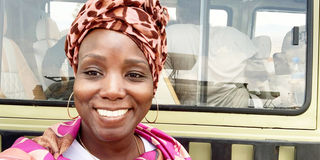Bridging two worlds: Christine uses travel to connect children to roots

What you need to know:
- Christine believes that the second generation of Tanzanians who were born in the Diaspora should still have a connection with the motherland, and tourism can help do just that.
More than two decades ago, Christine Lasway, by then in her early 20s, left Tanzania for the US for further studies.
“I came to the US to do my masters in global health and development,” she remembers.
Her mother was very instrumental in her stay in America; now in her mid-forties, she has become a mother to three sons of her own, sons that call the United States their home.
Christine, a native of Kilimanjaro, was used to going on safari as a child. It was only right that once her sons came of age, she would give them an opportunity to experience the sea adventure she had had growing up.
“I took my sons to Serengeti, Ngorongoro and Zanzibar,” she said. “Here in the US, parents always put a visit to Disney World on a must-do list for their kids, but for me, it was Serengeti, Ngorongoro and Zanzibar,” she chimed.
“By the way, I haven’t even taken my kids to Disney,” she laughed. Christine prioritised her homeland visit for her kids; “for me, my kids need to have ties to Tanzania,” she insisted.
Her children currently enjoy the duo nationality that only applies to persons under 18. Christine is blessed with a 13-year-old first-born son, followed by eight-year-old twins. Upon their visit to Tanzania, they adjusted so well to their new environment; they interacted well and enjoyed playing around.
“Their main need was constant access and availability of the internet; they wanted to connect with their people through their devices,” she elaborated. Her eldest son has grown to what Christine can only describe as “Pan African.” He loves Tanzania, and at 13 years of age, he already knows what he will do for Tanzania when she grows up. So the trip back home was such an excitement for him. “When he heard we were going to Tanzania, he had already done his research about where we were going, she exclaimed.
As everyone was getting excited about the trip to Serengeti, Ngorongoro, and Zanzibar, Christine’s first-born was exuberant about Tanzania’s infrastructure; he was more interested in seeing the newly constructed SGR, the railway running from Dar es Salaam to Morogoro. “He already knew the tallest building in Tanzania and who built it, he wanted to see the Tanzanite bridge,” she added. “Tourism is very broad; people have different interests,” she mentioned.
Christine’s trip to Serengeti was phenomenal. She was taken by her late cousin brother Deogratius Kinabo, who recently passed away, who was very knowledgeable about the wildlife; he was a tour guide for twenty years.

Though she didn’t enjoy the 10 hours of bumpy drive to the wilderness, the tales and information he shared about tourism were worth the trip. The most memorable time she and the kids had on the trip was the human interaction. They spent three hours with the Maasai community in Ngorongoro, learning about their culture and doing activities with the people.
They learned how to make fire from wood sticks, mix cow milk, cook their food, and even learn how to make jewellery from beads. They were even able to ask them questions, and one of them was the Maasai tattoos, about which they found out that a Maasai warrior would only get a special tattoo once he kills a lion, as a right of passage or a prerequisite to getting a bride, a practice that is now absolute, but the tales were nevertheless exciting.
“They couldn’t keep killing the animals; soon they would have gone extinct, with the way the Maasai population has gone up,” she said, “so they had to stop.”
The head of the Maasai Boma took Christine’s eldest son aside for a private talk about leadership and helped her kid understand where they are from and truly get in touch with his roots.
Afterward, they headed to the spice island of Zanzibar. Her kids fell in love with the water sports on the island; they were fully engaged in swimming with the dolphins, snorkelling, and jet skiing. They participated in almost all the water sports Zanzibar is famously known for.
The popular Forodhani garden, known for its spicy and colourful food, was not what Christine remembered it used to be; “the food wasn’t as tasty as it used to be.” She was slightly disappointed, but she found joy in chatting with the “diving boys” who stand at Forodhani and dive into the Indian Ocean, carrying banners and pictures that gained social media fame when Lupita visited and even dived with them. She even used the boys to surprise her friend Zawadi, who had a birthday in Zanzibar.
“I had a banner for my friend Zawadi; I wanted the boys to dive with; it was a surprise, so I had to wait with the boys for Zawadi to show up; I used that time to bond and get to know them,” she narrated.
“I am still in touch with one of them, and I am mentoring him,” she added.
Christine has used her connection, experience, and love for her motherland to persuade Americans to visit Tanzania. She has now immersed herself in the promotion of Tanzanian tourism in the US, and she is the current president of DICOTA, the “Diaspora Council of Tanzanians in America, under which they have organised a tourism conference that will take place in Austin, Texas, on September 26–29.
“I always want to do something meaningful for Tanzania,” she said. “And I thought tourism was the best option, based on how it can impact the country, plus I consulted different stakeholders’’ she informed. This is an opportunity for all Tanzanians in the diaspora to come together and be proud of our country. “The ambition of five million visitors by 2025 can be achieved if the diaspora is fully involved,” she insisted.
Christine believes that the second generation of Tanzanians who were born in the Diaspora should still have a connection with the motherland, and tourism can help do just that.




